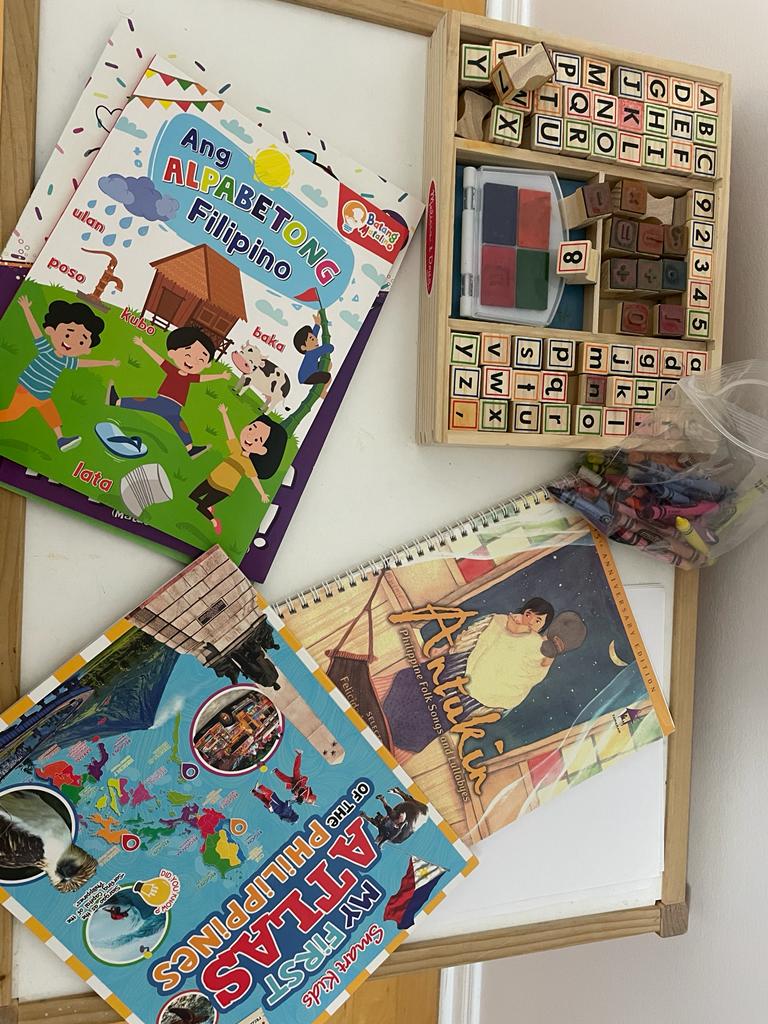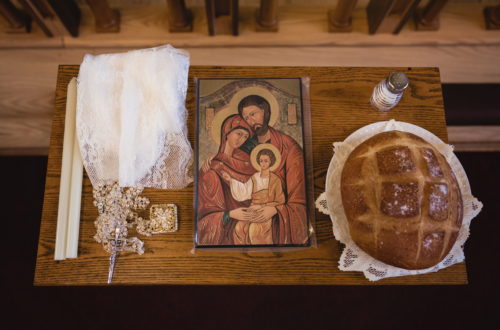
Teaching Tagalog to Your Kids While Living in Another Country
As parents, we all have things we want to teach our children, such as necessary skills and our own interests, values, wisdom, and faith. For example, my husband has taken to teaching our daughter about space and the solar system—now she knows all the names of the planets, moons, and more trivia than me. When our daughter started taking an interest in letters at two years old, we nurtured her curiosity by getting letter-oriented toys like puzzle, magnets, and stamps, and we started teaching her phonics too. Sometimes, I tried to introduce other themes, such as human anatomy and rocks, but as she’s shown little interest in these topics, I put materials away to try for another time. By following what could hold her attention and what she wanted to spend time on, my husband and I were still able to introduce a lot of concepts and life skills for her.
An early start
One of the things that we agreed we wanted to pass on, early on in our relationship and way before we got married, was our respective native cultures and language. We were very firm in this stance, as we both were proud of our heritage. My husband’s Polish, and as we live closer to his side of the family, I was not too worried about our daughter learning his language and culture. Of course, I had made a decision as well to learn as much Polish as I can, as initially I was under the impression that we could only teach our baby one language at a time.
When my daughter was 18 months old and had her wellness check with her doctor, she was only able to consistently speak 8 words. This was below the minimum expected of other children her age. We were referred to a speech therapist, but there was a wait to see one in our community. However, as part of the triage and to open our file, I was able to speak to a speech therapist over the phone to better explain our situation. He instructed me to start speaking to my daughter in the language I was most comfortable in.
I was aghast because I thought all this time that I could only speak in one language so as not to confuse my daughter, when in reality it would have helped her greatly if I had started speaking other languages more! I started doing this, and within two months, her language exploded.
Now she is very much fluent in two languages (Polish and Tagalog) and is able to understand and speak some English. We especially always get compliments from people, particularly Filipinos, who are amazed that she speaks Tagalog well. I suppose it’s because a lot of Filipinos overseas would prioritize their children learning to speak the foreign country’s language so that they wouldn’t have that recognizable Filipino accent.
Regardless of the reason, I firmly believe that passing on the Tagalog language (both the vernacular and the more poetic written), literature, history, and culture is very important. If you are like me and are also committed to teaching your child(ren) your native language, and it is especially more difficult when living in another country, here are other tips (from my experience).
Teaching your child another language
- Start early. I already hinted at this above. The earlier you start introducing the language to your child, the better they will learn it. Even as babies, they can at least be familiar with the sound and rhythm of the language, and eventually even unconsciously pick up on vocabulary and grammar rules without explicit instruction.
- Speak the language properly and consistently. You will have to make an effort to speak the language you want to teach (ideally your native language or one that you are fluent in) on a regular basis (or all the time). This will teach them the language on a conceptual and practical level. If multiple languages are spoken in your home, what I was told was that as long as the child associates one language with one parent or caretaker, the child will learn to switch between/among languages. And this has been our experience as well! In fact, our daughter has gotten so good in switching from one language to another that she translates for both me and my husband.
- Engage in conversations. Have regular conversations (however one-sided at first) with your child in the language you want to teach. This will prompt them to speak and develop their listening skills. Do remember to give them a chance to respond or at least to process what you are saying! For babies, you can start by just narrating what you see, what you’re doing. As they get older, you can ask them about their day, give instructions, talk about more complicated topics, encourage discussion… Right now, our daughter is having fun trying to find rhyming words, and it’s so much fun at this point.
- Use several immersion techniques. You may eventually get tired of talking or run out of things to say, but don’t worry! There are other options to expose your child to the language. These can include playing music, watching movies or TV shows, or reading books in your native language. Keep an eye out for cultural events and language immersion or community programs you and your child can attend. I am trying to ensure my child interacts frequently with other people who also speak Tagalog, which is what I’m trying to teach. We also occasionally watching short videos on YouTube, and I also sing a lot of Tagalog songs to her. Now my daughter even has the Philippine national anthem memorized!
- Utilize language resources. You can purchase or make materials to support your child’s language development, such as flashcards, books, or online language courses (for older kids). Interactive apps and educational videos can also be effective tools to engage your child in language learning. I asked friends and relatives to send me children’s stories, a Bible, and other books and workbooks that my daughter can use now and through many years.
The particulars of the Tagalog language and its teaching
While the above advice for teaching a second language holds for most languages, there are certain peculiarities to the Tagalog language that may make teaching it slightly different. For one, the vernacular is usually a mix of Tagalog and English, with a lot of words drawn from the Spanish language. This is different from proper Tagalog, which is usually used in more formal writing (and, less commonly, speaking). That said, proper Tagalog words should be used: for example, luntian for ‘green’ instead of berde (from the Spanish verde), bughaw for ‘blue’ instead of asul (from the Spanish azul), and parisukat for ‘square’ instead of kwadrado (from the Spanish quadrado).
Second, Tagalog doesn’t have gendered nouns and declinations. This is probably the reason why Filipinos, when speaking English, inadvertently misspeak and interchange ‘he’ and ‘she.’ I know I do!
Tagalog is made more complex, however, because it has a great number of prefixes and suffixes that can be added to a root word to change the meaning. Take the word kain, for example, which means ‘to eat’. Adding ku and changing the word to kumain loosely means ‘have eaten,’ with the object being a person who did action. Meanwhile, adding ki and changing the word to kinain means ‘was eaten’ and has the food as an object. Kinainan, on the other hand, means ‘from where the food was eaten,’ which has as the object either a vessel (plate or bowl) or a place (like a restaurant). These rules are better absorbed than learned systematically, hence the importance of starting early.
Fourth, Tagalog has a lot of unofficial contractions and shortcuts, and we also like peppering our sentences with po as a gesture of politeness. For example, I use kaw instead of ikaw (’you’ in English), and di instead of hindi (’no’ or ‘not’ in English, depending on use). I have had to explain myself sometimes to my daughter so she understands what I mean.
Finally, Tagalog words can be spelled the same but mean differently, depending on where the emphasis is on the spoken word. For example, bása (accent on the first syllable) means ‘to read’ in English, while basá (accent on the second syllable) means ‘wet’ in English. Another example: sáma means ‘to accompany,’ while samá means something ‘bad.’
The great thing about Tagalog, however, is that the way the word is spelled is how it’s pronounced, and interestingly, a vast majority of the words mean what they sound like. I find this helps greatly with spelling and comprehension. Give it a try! What do you think when you hear the word kilig? Don’t you just feel the butterflies flutter in your belly?
Benefits of being multilingual
With people traveling and most developed countries becoming more culturally diverse, it is not difficult to find bilingual and multilingual people. We all know that speaking more than one language offers many benefits and opportunities, such as increases career options, better understanding and empathy towards other people, and overall improved communication skills.
For children, learning multiple languages also enhances cognitive skills, including problem-solving, critical thinking, creativity, and even memory. Children also learn to become flexible and are more quick to adapt in different social situations. Finally, for our family, teaching our daughter our respective native languages preserves our national heritage and traditions. We are very thankful that we are able to share part of our identity with her.




2 Comments
Kristine
I love this blog and I’m on the same boat! Gusto ko din matuto yung baby namin ng Tagalog. Hindi lang makaintindi kundi makapagsalita din ng fluent someday. Questions if you dont mind:
1) Pano mo usually hinahandle kapag nakikipagusap ka sa bata and as you know minsan may mga English words na walang Tagalog equivalent. Kaya minsan taglish ko sya nakakausap. Kailangan ko ba 100% tagalog sya kausapin all the time?
2) Any recomendations for materials like tagalog books, flashcards, dvds, etc?
Thank you!
Dr. Jade Marie Tomaszewski
Hello, Kristine! 🙂 If walang Tagalog equivalent, I usually go with the Polish word first and English as my third choice. Or I try to explain the concept in Tagalog and then use the English word. I find that Tagalog is limited when it comes to the sciences (which I’m trying to also teach), but not so much for literature. We have some songs that are classics that use proper Tagalog words (and that are poetic and just beautiful to listen to), so I tend to use those songs when teaching. So from my experience, yes, better if 100% Tagalog! If not possible, don’t worry, it’s meant to be progressive learning anyway, done over years.
As for recommendations, the books pictured in this blog post are some of my daughter’s favorites. We also have Tagalog for Kids flashcards and several books on mga alamat. My daughter really liked the Antukin book, and it features folk songs from Luzon, Visayas, and Mindanao, and with sheet music too! The Atlas is good for introducing Filipino culture (festivals, national symbols, geography).
Hope this helps! 🙂